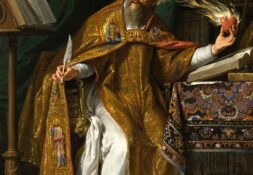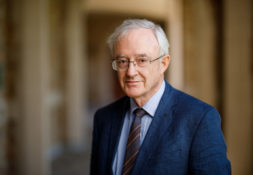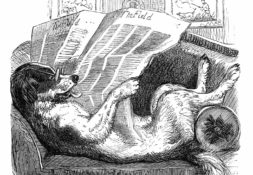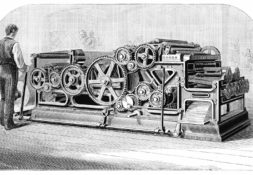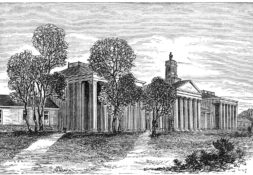I recently took special notice of one of the museum cases in Notre Dame’s Basilica of the Sacred Heart. This case stands under the main church and in the room behind the main altar of the Crypt of the Basilica. It contains a portrait of Archbishop John Carroll as well as his crozier and pectoral cross, artifacts recalling this first bishop appointed for the United States.
In retrospect, I realize that there were two reasons why I halted on this occasion and examined more closely the contents of this case. I took my bachelor’s degree from Georgetown University and was about to make a rare return to celebrate the fiftieth anniversary of that commencement.
At Georgetown, one is often reminded, if only by the statue of John Carroll at the main entrance to its campus, of this young Jesuit’s leading role as the founder of this oldest of American Catholic universities, a founding of 1789, the very year in which our new national Constitution took effect. So what were these artifacts recalling the Archbishop Carroll doing at Notre Dame, buried among the many items of this university’s American and Catholic history?
A second reason that led me to pause before the display case is that the eminent Carroll family of Maryland was just then much on my mind, for I was reading a biography of Charles Carroll, the cousin of the archbishop and, outside of Catholic circles, better known than him. Charles was the sole Catholic among the signers of the Declaration of Independence, and he became especially famous for outliving all the signers, including Jefferson and Adams who both met their seemingly fated deaths on the very golden anniversary of the proclamation of the Declaration in 1776.
The book I was reading is titled AMERICAN CICERO: THE LIFE OF CHARLES CARROLL. The author is Bradley J. Birzer, a professor of history at Hillsdale College. The book was published just last year, and it is modest in length but very illuminating of Charles Carroll’s thinking and writing in the struggles for American independence, for full citizenship for Catholics, and for the adoption of the new Constitution.
Birzer’s book is one in a series of books that is among scholarly efforts in the last two generations to attend more adequately to “neglected figures of the American Founding,” those called “the forgotten founders” – the more than one hundred individuals who took leadership roles in the state-colonies and in national conventions and whose thought and actions are very little known to us compared to that of the likes of Jefferson, Adams and Madison. It was in this context that I turned to learn more about Charles Carroll and clearly with the additional motivation to understand how a devout and educated Catholic handled the issues of that tumultuous time and how he might have thought about the principles and ideas that informed the American Founding.
Before relating just a few of the notable aspects in Birzer’s account, it is proper to bring our University of Notre Dame back into the picture. Birzer, it happens, is a Notre Dame graduate who majored in history as he discovered his profession of teaching and research and prepared himself for it. More significant surely in tying the Carrolls to Notre Dame and likely the justification for the artifacts of the archbishop in the Crypt is the fact that the first ordination on US soil was done by John Carroll on Stephen Badin, a priest destined for the Indian missions of this part of the world and the one who would purchase the land on which Notre Dame and her Badin Hall stand.
Even more significant, not alone because it involves both Carrolls directly, is their joint and coordinated contributions to American freedom and the successful emergence of a unified constitutional republic, an American society where the tradition of Catholicism would be free to contribute to the maintenance and nurturing of the necessary moral and religious underpinnings of that republic. Notre Dame is so clearly the beneficiary of that legacy of the Carrolls and in a special way the custodian of it in modern America.
In this brief essay, as in Birzer’s book, further attention must be limited to Charles Carroll though the contribution he shared with his cousin John is tangibly symbolized in an endeavor Birzer brings to the attention of readers. Early in 1776, Charles and his cousin John, the young priest, were called by the Continental Congress conducting the Revolutionary War and soon to issue the Declaration of Independence, to join Benjamin Franklin and Samuel Chase in a diplomatic mission to Canada. They went to secure Canadian support in the coming war in the face of not unreasonable fears there that Roman Catholics were, if not persecuted, clearly under legal disabilities in the American colonies.
Both Charles and his cousin grew to be friends with Franklin through this endeavor; Birzer observes specifically of John’s friendship with Franklin that it was “deep and lasting” and remarkably a friendship with “the most liberal, secular and Enlightenment-oriented of all the Founding Fathers.” Later as archbishop, John would comment to Charles on their joint work for Catholic freedom within a then free American nation: “The concerns of our religion in this country are placed equally under my superintendence; and under God, its chief protection has long been owing to the influence and preponderance of yourself and your venerable Father before you.”
Ironically Charles, considered by some the best educated man in America then and acknowledged by most to be the wealthiest, labored under the legal disabilities of being unable to vote and hold office at a time of intense anti-Catholicism in Maryland. He made his way into politics in the extra-legal and informal councils and conventions that developed in the run-up to and through the Revolution. His early and manifest support for the principles articulated in the Declaration of Independence and his constant patriotism, even when legally disabled, won him the support of many.
Later Charles observed that when he signed the Declaration, he “had in view not only our independence of England but the toleration of all Sects, professing the Christian Religion, and communicating to them all great rights”; and he delighted that such a “wise and salutary measure has taken place for eradicating religious feuds and persecution.” Then recalling the proscriptions on Roman Catholics in Maryland, he added “that I had much at heart this grand design founded on mutual charity, the basis of our holy religion.”
Like many of the Founders, Charles Carroll admired the stability and balance of the British constitution; he thought corruption had overtaken the system there and hoped that such a constitutional achievement in the natural rights and natural law tradition might be restored on a new basis in the United States. He worked for the abolition of slavery and especially for aspects of the Constitution, like the Senate, where he served, that might check what he considered destabilizing democratic tendencies. He thought that this American republic inspired by the Declaration of Independence could be one of the happiest political experiences in history, yet he warned that its “protracted existence . . . will depend on the morality, sobriety and industry of the people.”
The principles and the prudence he drew upon in his political life reflected the Christian humanist education he received in France followed by a subsequent period of pre-legal and legal education in France and England. During this latter phase, his reading of Montesquieu played an important part. John, his clerical cousin, received a similar French education in the Christian humanist tradition.
Birzer calls Charles the “American Cicero” for a number of reasons. Though not a renowned orator like Cicero, he rather used public essays to defend republican principles much like those embraced by Cicero; he regularly invoked Cicero and exemplified Cicero’s devotion to the common good. The concepts of virtue and wisdom, so critical to Cicero and to the tradition in which he stood, were readily called on by Charles Carroll as, for instance, in his expressions of esteem for George Washington.
Reminiscent of the attachments of St. Jerome, Carroll once remarked that “after the Bible and the following of Christ, give me, sir, the philosophic works of Cicero.” Alexis de Tocqueville, upon interviewing Charles Carroll during his significant and fruitful visit to the United States, noted that “this race of men is disappearing now after having provided America with her greatest spirits.” Upon his death a few years later, an American newspaper described Carroll as “the last of the Romans.”
The Carrolls’ legacy to Notre Dame is not simply the gift of freedom, specifically the freedom of Catholics, in a stable republic, but also the challenge to contribute to personal enrichment and public leadership by developing and nourishing in this land an education in Christian humanism appropriate to this time.
Walter Nicgorski is a professor in the Program of Liberal Studies and a concurrent professor of political science. He also serves as a faculty advisor to The Rover. He can be contacted at Walter.J.Nicgorski.1@nd.edu.
